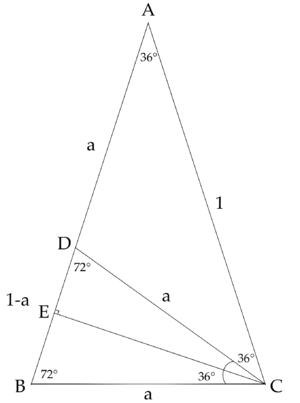2023 AMC 12B Problems/Problem 25
- The following problem is from both the 2023 AMC 10B #25 and 2023 AMC 12B #25, so both problems redirect to this page.
Contents
Problem
A regular pentagon with area ![]() is printed on paper and cut out. The five vertices of the pentagon are folded into the center of the pentagon, creating a smaller pentagon. What is the area of the new pentagon?
is printed on paper and cut out. The five vertices of the pentagon are folded into the center of the pentagon, creating a smaller pentagon. What is the area of the new pentagon?
![]()
Solution 1
Let the original pentagon be ![]() centered at
centered at ![]() . The dashed lines represent the fold lines. WLOG, let's focus on vertex
. The dashed lines represent the fold lines. WLOG, let's focus on vertex ![]() .
.
Since ![]() is folded onto
is folded onto ![]() ,
, ![]() where
where ![]() is the intersection of
is the intersection of ![]() and the creaseline between
and the creaseline between ![]() and
and ![]() . Note that the inner pentagon is regular, and therefore similar to the original pentagon, due to symmetry.
. Note that the inner pentagon is regular, and therefore similar to the original pentagon, due to symmetry.
Because of their similarity, the ratio of the inner pentagon's area to that of the outer pentagon can be represented by
![]()
Option 1: Knowledge
Remember that ![]() .
.
Option 2: Angle Identities
![]()
![]()
![]()
![]()
![]()
![]()
![]()
Let the inner pentagon be ![]() .
.
![]()
![]()
![]()
![]()
-Dissmo
Solution 2
![[asy] unitsize(5cm); // Define the vertices of the pentagons pair A, B, C, D, E; pair F, G, H, I, J; // Calculate the vertices of the larger pentagon A = dir(90); B = dir(90 - 72); C = dir(90 - 2*72); D = dir(90 - 3*72); E = dir(90 - 4*72); // Draw the larger pentagon draw(A--B--C--D--E--cycle); pair O = (A+B+C+D+E)/5; pair AA,OO; real gap = 0.02; AA = A+(0,0); OO = O+(0,0); draw(AA--OO, blue); pair OOO, OAO; OOO = O+(gap,0); OAO = (O+A)/2 + (gap,0); draw(OOO--OAO,green); dot(O); dot((O+A)/2); label("$r_b$", (O+A)*.7, E,blue); label("$a_s$", (O+A)*.2 +(0+0.18,0.05), E,green); label("$r_s$", O+(-0.175,0.2), E,pink); real scaleFactor = 1/1.618; // Adjust this value as needed // Rotate the smaller pentagon by 180 degrees F = (1 - scaleFactor) * (0,0) + scaleFactor * dir(90 + 180); G = (1 - scaleFactor) * (0,0) + scaleFactor * dir(90 - 72 + 180); H = (1 - scaleFactor) * (0,0) + scaleFactor * dir(90 - 2*72 + 180); I = (1 - scaleFactor) * (0,0) + scaleFactor * dir(90 - 3*72 + 180); J = (1 - scaleFactor) * (0,0) + scaleFactor * dir(90 - 4*72 + 180); // Draw the smaller pentagon draw(F--G--H--I--J--cycle,red); draw(arc(O,(H+I)*.5*.6,H*.6)); label("$36^\circ$",O+(+0.05,0.15),NW); draw(O--H,pink); [/asy]](http://latex.artofproblemsolving.com/0/f/a/0fa13003b42a94bd7790e1a246ef96e98ea136e0.png)
Let ![]() and
and ![]() be the circumradius of the big and small pentagon, respectively. Let
be the circumradius of the big and small pentagon, respectively. Let ![]() be the apothem of the smaller pentagon and
be the apothem of the smaller pentagon and ![]() and
and ![]() be the areas of the smaller and larger pentagon, respectively.
be the areas of the smaller and larger pentagon, respectively.
From the diagram:

![]() ~Technodoggo
~Technodoggo
Solution 3
Interestingly, we find that the pentagon we need is the one that is represented by the intersection of the diagonals. Through similar triangles and the golden ratio, we find that the side length ratio of the two pentagons is ![]() Thus, the answer is
Thus, the answer is ![]() .
. ![]() ~andliu766
~andliu766
Supplement (Calculating sin54/cos36 from Scratch)
Construct ![]() with
with ![]() ,
, ![]() and
and ![]() with
with ![]() ,
, ![]() . WLOG, let
. WLOG, let ![]() ,
, ![]() ,
, ![]() .
.
![]()
![]()
![]()
![]()
Video Solution 1 by SpreadTheMathLove
https://www.youtube.com/watch?v=ROVjN3oYLbQ
Video Solution 2 by OmegaLearn
See also
| 2023 AMC 10B (Problems • Answer Key • Resources) | ||
| Preceded by Problem 24 |
Followed by Last Problem | |
| 1 • 2 • 3 • 4 • 5 • 6 • 7 • 8 • 9 • 10 • 11 • 12 • 13 • 14 • 15 • 16 • 17 • 18 • 19 • 20 • 21 • 22 • 23 • 24 • 25 | ||
| All AMC 10 Problems and Solutions | ||
| 2023 AMC 12B (Problems • Answer Key • Resources) | |
| Preceded by Problem 24 |
Followed by Last Problem |
| 1 • 2 • 3 • 4 • 5 • 6 • 7 • 8 • 9 • 10 • 11 • 12 • 13 • 14 • 15 • 16 • 17 • 18 • 19 • 20 • 21 • 22 • 23 • 24 • 25 | |
| All AMC 12 Problems and Solutions | |
The problems on this page are copyrighted by the Mathematical Association of America's American Mathematics Competitions. 











